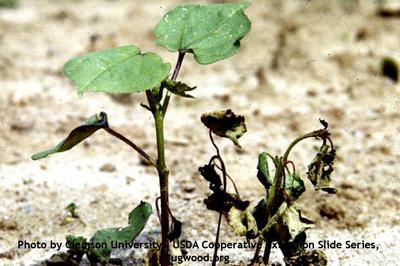Soreshin
Rhizoctonia solani
Fungus
In a Nutshell
- Irregular-shaped black to reddish brown lesion on the stem of the seedlings.
- Girdled stems.
- Plants may die.
Can also be found in
Symptoms
Sunken, oval- to irregular-shaped and reddish brown to black lesions appear on seedling stems. Plants often die as the lesions girdle the stems of cotton seedlings. Superficial fungal growth may be present on the surface of the lesion, from which soil particles often adhere. Infection and lesion development often occur below the soil line, but as the stem grows and elongates, the lesions may be apparent at the soil’s surface.
Recommendations

Organic Control
Don’t plant if cold or rainy weather is expected in the next 4 -5 days. Don’t plant deeper than 5 cm.

Chemical Control
Always consider an integrated approach with preventive measures together with biological treatments if available. Fungicide treatmetns with etridiazole, copper oxychloride, tolclofos-methyl, thiabendazole, thiram and captan significantly increase the percentage of seedling emergence and decrease the disease index in cotton seedlings.
What caused it?
The symptoms are cause by the soil fungus Rhizoctonia solani, which infects a large number of hosts. The mechanical injuries to the seedlings, for example during planting, favor the infection. When lesions occur near the soil line, they may be confused with abrasions to the tissues caused by the wind-driven whipping of the stem against a hard upper soil surface. As seedlings develop, they become naturally resistant to infection as root systems become more extensive and root cells become lignified.
Preventive Measures
- Monitor the orchard regularly for symptoms of the disease.
- Chose resistant or resilient varieties.
- Use disease free seedling material.
- Do not plant in wet soil.
- Do not irrigate during cool weather.
- Crop rotation with sorghum and small grains is recommended.
- Plant when soil temperatures are greater than 20°C.
- Plant on raised beds helps to increase soil temperatures and improve drainage.



